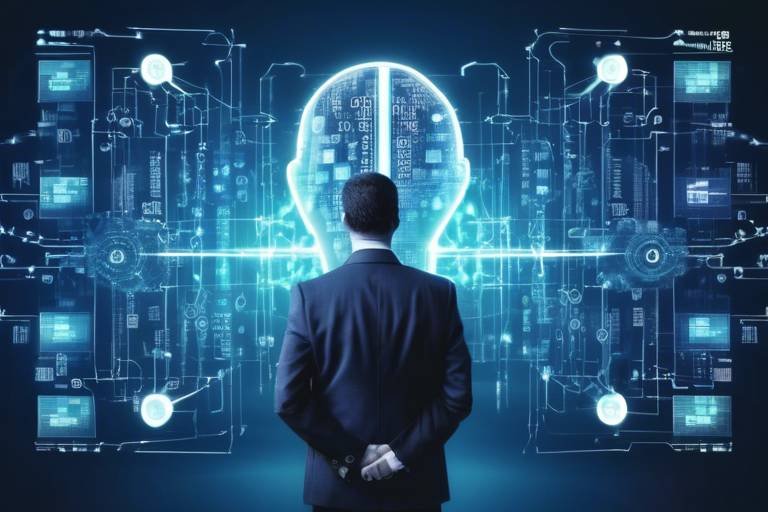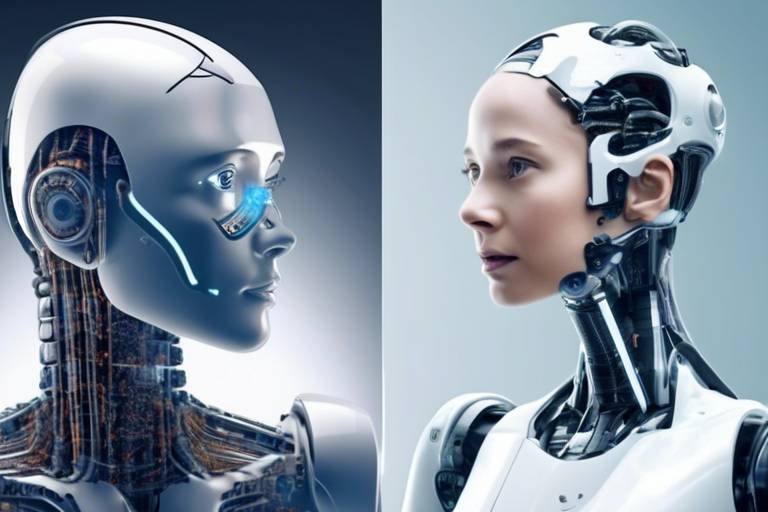AI in Human Resources: Changing HR Dynamics
Artificial intelligence (AI) is not just a buzzword; it's a game-changer in the realm of human resources (HR). Imagine a world where hiring decisions are made faster, employee engagement is enhanced, and performance management is data-driven. That's the reality we are stepping into, thanks to AI. This technology is revolutionizing HR practices, making them more efficient and effective. It’s like having a supercharged assistant that never sleeps, tirelessly working to improve every aspect of HR.
The integration of AI into HR processes is akin to upgrading from a flip phone to a smartphone. Just as smartphones have transformed communication, AI is reshaping how organizations manage their most valuable asset: their people. From recruitment to employee engagement, AI tools are becoming indispensable. They help HR professionals sift through mountains of data, identify trends, and make informed decisions that were once time-consuming and prone to human error.
One of the most exciting aspects of AI in HR is its ability to streamline processes. For instance, AI can automate mundane tasks like resume screening, allowing HR teams to focus on what truly matters: connecting with candidates and building a strong organizational culture. This automation not only speeds up the hiring process but also enhances the quality of talent acquisition by ensuring that the best candidates are identified and engaged.
Moreover, AI provides a wealth of data that can be analyzed to improve employee experiences. By understanding employee needs and preferences, organizations can tailor their approaches to learning and development, engagement, and retention. This level of personalization fosters a workplace environment where employees feel valued and understood, leading to increased satisfaction and productivity.
However, as we embrace the benefits of AI, it’s crucial to navigate the challenges that come with it. Issues such as algorithmic bias and data privacy must be addressed to ensure that AI is implemented ethically and responsibly. Organizations need to remain vigilant and proactive in creating policies that promote fairness and transparency, ensuring that AI serves as a tool for inclusion rather than exclusion.
In conclusion, the impact of AI on HR dynamics is profound and far-reaching. As we continue to explore this transformative technology, it's essential for HR professionals to stay informed and adaptable. The future of HR is not just about managing people; it's about leveraging technology to create a more engaged, productive, and satisfied workforce.
- What is the primary benefit of using AI in HR? AI helps streamline processes, improve hiring efficiency, and enhance employee engagement.
- How does AI affect recruitment? AI automates resume screening and candidate sourcing, making the hiring process faster and more efficient.
- What are the ethical concerns surrounding AI in HR? Key concerns include algorithmic bias and data privacy issues that need to be addressed to ensure fair practices.
- Can AI improve employee training? Yes, AI can provide personalized learning experiences and adaptive training programs tailored to individual employee needs.

The Role of AI in Recruitment
In today's fast-paced world, the recruitment landscape is undergoing a remarkable transformation, largely thanks to artificial intelligence (AI). Imagine a scenario where the tedious task of sifting through hundreds of resumes is no longer a burden for HR professionals. Instead, AI steps in like a superhero, streamlining the recruitment process and enhancing overall efficiency. By automating resume screening, AI not only saves valuable time but also ensures that the best candidates rise to the top of the pile. It's akin to having a highly skilled assistant who never tires and always keeps an eye on the details.
One of the most significant advantages of AI in recruitment is its ability to enhance candidate sourcing. Traditional methods often rely on manual searches and referrals, which can be limiting. AI, on the other hand, can scour the internet and various platforms to identify potential candidates who may not even be actively looking for a job. This proactive approach leads to a richer talent pool, allowing organizations to discover hidden gems that they might have otherwise overlooked.
Furthermore, AI tools can analyze vast amounts of data to identify patterns and trends in successful hires. By leveraging these insights, HR professionals can refine their recruitment strategies, tailoring their approaches to attract candidates who align with their company culture and values. It's like having a crystal ball that predicts which candidates will thrive in specific roles, ultimately leading to better talent acquisition.
However, while AI brings numerous benefits, it does come with its challenges. For instance, there's the potential for bias in AI algorithms, which can inadvertently affect hiring decisions. To combat this, organizations must ensure that their AI systems are trained on diverse datasets and regularly audited for fairness. This vigilance is crucial to creating an equitable hiring process that promotes diversity and inclusion.
In summary, the role of AI in recruitment is not just about efficiency; it's about revolutionizing the way organizations attract and select talent. By automating mundane tasks, enhancing candidate sourcing, and providing data-driven insights, AI empowers HR professionals to focus on what truly matters—building a strong and diverse workforce that drives organizational success.

Enhancing Employee Experience with AI
In today's fast-paced corporate world, employee experience has become a critical factor in determining the success of an organization. With the advent of artificial intelligence (AI), companies are now equipped with powerful tools to enhance this experience significantly. Imagine walking into a workplace where your personal preferences are understood, your training needs are anticipated, and your performance feedback is delivered in real-time. Sounds like a dream, right? Well, AI is making it a reality.
One of the most exciting applications of AI in enhancing employee experience is through personalized learning and development programs. Traditional training methods often adopt a one-size-fits-all approach, which can leave employees feeling disengaged and undervalued. AI-powered platforms, however, can analyze individual learning styles, preferences, and performance metrics to create tailored training solutions. This not only helps employees acquire the skills they need but also fosters a sense of ownership over their professional growth.
These innovative platforms leverage AI technologies to deliver customized training experiences. For instance, they can recommend specific courses based on an employee's current skill set and career aspirations. This level of personalization ensures that employees receive relevant knowledge that directly impacts their roles, making learning more engaging and effective. Moreover, companies can track progress in real-time, allowing for timely adjustments to training strategies.
Adaptive learning technologies take personalization a step further. By continuously analyzing an employee's performance, these systems can modify training materials to suit individual needs. For example, if an employee struggles with a particular concept, the platform can provide additional resources or alternative explanations to help them grasp the material better. This dynamic approach not only enhances the learning experience but also boosts confidence and competence.
Imagine having a personal coach available at your fingertips 24/7. AI-driven virtual coaching tools offer just that. These tools provide real-time feedback, guidance, and support, enabling employees to navigate challenges and seize opportunities for growth. Whether it’s preparing for a presentation or managing a project, virtual coaching can help employees refine their skills and enhance their performance. This level of support fosters a culture of continuous improvement and engagement, making employees feel valued and empowered.
AI doesn’t stop at learning and development; it also plays a crucial role in performance management. By utilizing data analytics, HR professionals can conduct objective performance evaluations. This data-driven approach helps in making informed decisions regarding promotions, raises, and employee development. Instead of relying solely on subjective opinions, organizations can leverage concrete data to recognize top performers and identify areas for improvement. This transparency builds trust within the workforce and aligns individual goals with organizational objectives.
In summary, AI is revolutionizing the employee experience by offering personalized learning, real-time coaching, and data-driven performance management. As organizations continue to embrace these technologies, the potential for creating a more engaging and satisfying workplace is enormous. Employees no longer have to feel like just another cog in the machine; they can thrive in an environment that recognizes and nurtures their unique contributions.
- How does AI personalize learning for employees?
AI analyzes individual performance data and learning preferences to create customized training programs that meet specific needs. - What are the benefits of AI-driven virtual coaching?
AI-driven virtual coaching provides real-time feedback, helping employees improve their skills and navigate challenges effectively. - Can AI help in performance evaluations?
Yes, AI can analyze performance data to provide objective evaluations, which helps in making informed decisions about promotions and development. - What ethical concerns should organizations consider with AI?
Organizations should be aware of potential biases in AI algorithms and ensure data privacy and security for employee information.

AI-Powered Learning Platforms
In today's fast-paced work environment, are revolutionizing how organizations approach employee training and development. These innovative systems utilize artificial intelligence to create personalized learning experiences that cater to the unique needs of each employee. Imagine walking into a training session that feels tailor-made just for you—this is the magic of AI!
One of the most significant benefits of AI-powered learning platforms is their ability to analyze vast amounts of data to identify individual learning styles and preferences. By assessing how employees engage with training materials, these platforms can adapt content in real-time, ensuring that each learner receives the most relevant information. This level of customization not only enhances knowledge retention but also boosts motivation, as employees feel more connected to their learning journey.
Moreover, AI-driven platforms can offer a variety of learning formats, from interactive videos to gamified assessments. This diversity keeps the learning process engaging and helps employees absorb information more effectively. For instance, an employee struggling with a specific topic might receive additional resources or alternative explanations that resonate better with their understanding. It's like having a personal tutor available 24/7, ready to help whenever needed!
To illustrate the impact of AI in learning, consider the following table that highlights key features of AI-powered learning platforms:
| Feature | Description |
|---|---|
| Personalization | Adapts learning paths based on individual performance and preferences. |
| Real-Time Feedback | Provides immediate insights on progress and areas for improvement. |
| Content Variety | Offers multiple formats, including videos, quizzes, and interactive modules. |
| Scalability | Easily accommodates a growing workforce and diverse learning needs. |
In addition to these features, AI-powered learning platforms can also integrate with existing HR systems, making it easier to track employee progress and align training with organizational goals. This seamless integration ensures that learning and development initiatives are not just an afterthought but a strategic component of the business. Companies can identify skill gaps and tailor training programs accordingly, which helps in nurturing a more competent and agile workforce.
Ultimately, the rise of AI in learning platforms signifies a shift towards a more dynamic and responsive training culture. As organizations embrace these technologies, they are not only investing in their employees' growth but also paving the way for a more innovative and skilled workforce. The future of learning is here, and it’s powered by AI!
- What are AI-powered learning platforms?
These are training systems that use artificial intelligence to personalize learning experiences based on individual needs and preferences. - How do they enhance employee training?
By analyzing data on employee performance, these platforms adapt content in real-time, ensuring that training is relevant and effective. - Can AI learning platforms integrate with existing HR systems?
Yes, they can seamlessly integrate, allowing for better tracking of employee progress and alignment with organizational goals. - What types of content do these platforms offer?
They provide a variety of formats, including videos, quizzes, and interactive modules, to cater to different learning styles.

Adaptive Learning Technologies
In today's fast-paced work environment, are revolutionizing how employees acquire new skills and knowledge. Imagine a training program that evolves with you, adjusting to your unique learning pace and style. This is no longer just a dream; it’s a reality powered by artificial intelligence. These systems analyze an employee's performance in real-time, identifying strengths and weaknesses, and then tailoring the educational content to suit individual needs. It’s like having a personal trainer for your career!
These technologies not only enhance learning efficiency but also foster a culture of continuous improvement within organizations. They provide a personalized experience that traditional training methods simply cannot match. For instance, if an employee struggles with a particular concept, the system can automatically offer additional resources or alternative explanations. This level of customization ensures that no one is left behind, promoting a more inclusive workplace.
Moreover, adaptive learning platforms can gather data on how employees interact with the training materials. This data is invaluable, as it allows HR professionals to track progress and assess the effectiveness of various training modules. By leveraging this information, organizations can refine their training programs, ensuring they remain relevant and impactful. The result? A workforce that is not only skilled but also engaged and motivated to learn.
To illustrate the effectiveness of adaptive learning technologies, consider the following table that compares traditional training methods with adaptive learning:
| Feature | Traditional Training | Adaptive Learning |
|---|---|---|
| Customization | Standardized for all | Personalized to individual needs |
| Feedback | Delayed feedback | Real-time feedback |
| Engagement | Passive learning | Interactive and engaging |
| Progress Tracking | Limited tracking | Comprehensive data analysis |
In essence, adaptive learning technologies represent a significant leap forward in employee training and development. They not only cater to the diverse learning styles of employees but also empower them to take charge of their professional growth. As organizations continue to embrace these innovative solutions, they will undoubtedly see a boost in both employee satisfaction and overall productivity.
- What are adaptive learning technologies?
Adaptive learning technologies are systems that adjust educational content based on an individual's performance and learning style, providing a personalized learning experience. - How do adaptive learning technologies benefit organizations?
They enhance employee engagement, improve skill acquisition, and allow for more effective tracking of training progress. - Can adaptive learning technologies be integrated with existing training programs?
Yes, many adaptive learning platforms can be integrated with traditional training programs to enhance their effectiveness.

Virtual Coaching and Mentoring
In today's fast-paced world, the concept of has gained significant traction, transforming how employees develop their skills and enhance their careers. Imagine having a personal coach available at your fingertips, ready to provide insights and feedback, no matter where you are. This is the magic of AI-driven virtual coaching tools. They offer real-time support, making professional growth more accessible than ever before.
These digital coaches use sophisticated algorithms to analyze an employee's performance, identify strengths and weaknesses, and provide tailored advice. Think of it as having a GPS for your career journey—guiding you through the twists and turns while ensuring you stay on the right path. With these tools, employees can receive personalized learning experiences that align with their career goals.
One of the most compelling aspects of virtual coaching is its ability to facilitate ongoing feedback. Traditional mentoring often involves scheduled meetings, which can sometimes feel disconnected from the day-to-day challenges employees face. In contrast, virtual coaching offers immediate assistance. For example, if an employee struggles with a specific task, they can receive instant guidance, which not only boosts their confidence but also enhances their productivity.
Furthermore, virtual coaching fosters a culture of continuous learning. Employees are encouraged to seek help whenever they need it, breaking down the barriers that often exist in traditional workplace environments. This leads to a more engaged workforce, as employees feel supported in their development. According to recent studies, organizations that implement virtual coaching see a significant increase in employee satisfaction and retention rates.
However, it's essential to address the challenges that come with this innovative approach. While virtual coaching provides numerous benefits, organizations must ensure that these tools are user-friendly and accessible to all employees. Additionally, maintaining a balance between AI-driven support and human interaction is crucial. After all, while AI can provide valuable insights, the human touch remains irreplaceable in mentoring relationships.
In summary, virtual coaching and mentoring represent a significant leap forward in employee development. By leveraging AI technology, organizations can empower their workforce to achieve their full potential, creating a more dynamic and engaged workplace. As we move forward, it's clear that the future of mentoring is not just virtual—it's also incredibly promising.
- What is virtual coaching? Virtual coaching is an AI-driven approach that provides employees with real-time feedback and guidance to support their professional growth.
- How does virtual coaching differ from traditional mentoring? Unlike traditional mentoring, which often relies on scheduled meetings, virtual coaching offers immediate support and personalized learning experiences.
- Can virtual coaching improve employee engagement? Yes, by providing ongoing feedback and support, virtual coaching can significantly enhance employee engagement and satisfaction.
- What are the challenges of implementing virtual coaching? Some challenges include ensuring accessibility for all employees and maintaining a balance between AI support and human interaction.

Data-Driven Performance Management
In today's fast-paced business environment, has emerged as a game-changer for HR professionals. By leveraging the power of artificial intelligence, organizations can transform their approach to evaluating employee performance. Imagine being able to assess your team's strengths and weaknesses with pinpoint accuracy, much like a coach analyzing game footage to enhance player performance. This is the essence of data-driven performance management.
AI tools can collect and analyze a wealth of performance data, from productivity metrics to employee feedback, creating a comprehensive picture of an individual’s contributions. This objective data analysis allows HR professionals to make informed decisions regarding promotions, raises, and employee development. Instead of relying on subjective assessments, organizations can now base their evaluations on hard evidence, ensuring a fairer and more transparent process.
For instance, consider a scenario where an employee consistently meets or exceeds their targets. AI can track these achievements and present them in a digestible format, allowing managers to recognize and reward top performers swiftly. This not only boosts morale but also fosters a culture of recognition and appreciation within the workplace.
Moreover, data-driven performance management can help identify areas where employees may need additional support or training. By analyzing performance trends, organizations can pinpoint specific skills that require enhancement, thus tailoring development programs to meet individual needs. This personalized approach not only enhances employee satisfaction but also contributes to overall organizational effectiveness.
| Performance Metrics | Data Sources | AI Analysis |
|---|---|---|
| Productivity Levels | Project Management Tools | Identifies top performers and underperformers |
| Employee Feedback | Surveys and Reviews | Gauges employee satisfaction and engagement |
| Skill Development | Training Platforms | Recommends personalized learning paths |
However, while the benefits are clear, implementing a data-driven performance management system does come with its challenges. Organizations must ensure that the data collected is accurate, relevant, and used responsibly. Additionally, it’s vital to maintain open communication with employees about how their data is being used and to what end. After all, transparency fosters trust, and trust is a cornerstone of a productive workplace.
In conclusion, data-driven performance management powered by AI is not just a trend; it's the future of HR. By embracing this approach, organizations can unlock the full potential of their workforce, leading to improved performance, higher employee satisfaction, and ultimately, greater business success.
- What is data-driven performance management?
It is an approach that uses data and analytics to evaluate employee performance, ensuring decisions are based on objective evidence rather than subjective opinions. - How can AI improve performance management?
AI can analyze vast amounts of performance data, providing insights that help HR make informed decisions regarding promotions, training, and employee development. - What challenges come with implementing AI in performance management?
Challenges include ensuring data accuracy, maintaining employee trust through transparency, and addressing privacy concerns.

AI in Employee Engagement
The integration of artificial intelligence in employee engagement is revolutionizing how organizations connect with their workforce. Traditional methods of gauging employee satisfaction often fell short, relying on periodic surveys that could quickly become outdated. But with AI, companies can now tap into real-time data to understand how their employees feel and what drives their engagement levels. Imagine having a tool that can not only measure employee sentiment but also predict trends before they become apparent. This is the power of AI in employee engagement.
AI tools are capable of analyzing vast amounts of feedback from employees, gleaning insights that human analysts might miss. By utilizing natural language processing (NLP), these tools can assess the tone and sentiment of employee comments in surveys or feedback forms. For instance, if a company conducts a survey asking about job satisfaction, AI can analyze the open-ended responses to identify common themes, such as workload, management support, or career development opportunities. This level of analysis allows HR professionals to pinpoint specific areas that need attention, ensuring that interventions are both timely and relevant.
One of the standout features of AI in employee engagement is its ability to provide predictive analytics. This means that organizations can identify employees who may be at risk of disengagement or leaving the company altogether. By examining patterns in employee behavior and feedback, AI can flag individuals who might need additional support or recognition. For example, if an employee's engagement scores drop significantly over a few months, HR can intervene with tailored strategies to boost morale, such as offering professional development opportunities or more flexible work arrangements.
Furthermore, AI can enhance workplace culture by facilitating open communication. Tools powered by AI can analyze ongoing conversations in team chat platforms, helping leaders understand the pulse of their teams. By identifying positive and negative sentiments in real-time, managers can address issues before they escalate, fostering a culture of transparency and responsiveness. This proactive approach not only enhances employee satisfaction but also builds trust within the organization.
| AI Tools for Employee Engagement | Functionality |
|---|---|
| Sentiment Analysis Tools | Analyze employee feedback to gauge overall sentiment and morale. |
| Predictive Analytics | Identify trends and employees at risk of disengagement. |
| Real-time Feedback Tools | Gather continuous feedback to make timely adjustments in management practices. |
In conclusion, AI is not just a buzzword in the realm of employee engagement; it is a game-changer. By leveraging AI technologies, organizations can create a more engaged, satisfied, and productive workforce. The insights gained from AI tools enable HR professionals to make data-driven decisions that enhance the overall employee experience, leading to improved retention rates and a stronger organizational culture. As we move forward, the role of AI in shaping employee engagement will only continue to grow, offering exciting possibilities for both employees and employers alike.
Q: How does AI improve employee engagement?
A: AI improves employee engagement by analyzing feedback in real-time, identifying sentiment trends, and predicting potential disengagement, allowing organizations to take proactive measures.
Q: What are sentiment analysis tools?
A: Sentiment analysis tools use natural language processing to assess employee feedback, helping organizations understand overall morale and areas needing improvement.
Q: Can AI replace human interaction in employee engagement?
A: No, while AI can provide valuable insights, it should complement human interaction. Personal relationships and empathy are crucial in maintaining a positive workplace culture.
Q: How can predictive analytics help in retaining employees?
A: Predictive analytics can identify employees at risk of leaving by analyzing behavioral patterns, enabling HR to implement targeted retention strategies.

Sentiment Analysis Tools
In today’s fast-paced corporate world, understanding employee sentiment is more crucial than ever. are at the forefront of this effort, utilizing advanced technologies to decode the emotional tone behind employee feedback. Imagine you’re trying to decipher a friend’s mood based solely on their texts; it can be tricky, right? Now, think about doing this for hundreds or thousands of employees. That’s where these tools come into play, turning what would be an overwhelming task into a streamlined process.
These tools employ natural language processing (NLP) to analyze written feedback from various sources, such as surveys, emails, and social media posts. By interpreting the language used, sentiment analysis tools can categorize feedback as positive, negative, or neutral. This categorization provides organizations with a clear snapshot of employee morale and engagement levels. For instance, if a company receives a flood of negative comments about management practices, it can act swiftly to address these issues before they escalate.
Furthermore, sentiment analysis tools can identify specific themes or topics that resonate with employees. For example, if many employees mention "work-life balance" in their feedback, it signals an area that may need attention. By aggregating this data, HR professionals can gain insights into the overall workplace atmosphere and make informed decisions to enhance employee satisfaction. Below is a brief overview of how these tools can be beneficial:
| Benefits of Sentiment Analysis Tools | Description |
|---|---|
| Real-time Feedback | These tools provide immediate insights into employee sentiment, allowing for quick responses to emerging issues. |
| Data-Driven Decision Making | HR can leverage data from sentiment analysis to inform strategic decisions, fostering a more engaged workforce. |
| Enhanced Communication | By understanding employee feelings, organizations can improve internal communication strategies and address concerns effectively. |
However, while sentiment analysis tools offer numerous advantages, it’s essential to approach their implementation with care. Organizations must ensure that the data collected is not only accurate but also representative of the entire workforce. Otherwise, decisions made based on skewed data could lead to further disengagement among employees. Moreover, transparency about how the data will be used can help build trust within the organization.
In conclusion, sentiment analysis tools are revolutionizing how HR professionals gauge employee sentiment. By harnessing the power of technology, organizations can create a more responsive and engaged workplace. As we move forward, it’s exciting to imagine how these tools will evolve and further shape the dynamics of employee engagement.
- What is sentiment analysis? Sentiment analysis is a technique used to determine the emotional tone behind a series of words, helping to understand the attitudes and opinions of employees.
- How do sentiment analysis tools work? These tools utilize natural language processing to analyze text data, categorizing it into positive, negative, or neutral sentiments.
- Why is sentiment analysis important for HR? It helps HR professionals understand employee morale, identify areas for improvement, and make informed decisions to enhance workplace culture.
- Can sentiment analysis tools be biased? Yes, if the data used to train these tools is biased, it can lead to inaccurate interpretations. Organizations must ensure diverse and representative data.

Predictive Analytics for Retention
In today's competitive job market, retaining top talent has become a crucial priority for organizations. Enter predictive analytics—a game-changer in the realm of human resources. By leveraging data-driven insights, predictive analytics allows HR professionals to identify patterns and trends that can indicate which employees may be at risk of leaving. Imagine having a crystal ball that not only highlights potential flight risks but also provides actionable strategies to keep them engaged and satisfied!
How does it work, you ask? Predictive analytics utilizes a combination of historical data, employee feedback, and various metrics to create a comprehensive profile of employee behavior. For instance, factors such as job satisfaction levels, performance metrics, and even work-life balance can be analyzed to predict retention rates. This means that HR teams can proactively address issues before they escalate into turnover.
To illustrate the impact, let’s consider a hypothetical scenario involving a mid-sized tech company. By implementing predictive analytics, the HR department discovered that employees in certain departments were expressing dissatisfaction due to a lack of career advancement opportunities. Armed with this information, they initiated targeted development programs and mentorship opportunities. As a result, not only did employee engagement improve, but turnover rates in those departments dropped by an impressive 30% over the next year!
Here are some key benefits of using predictive analytics for retention:
- Proactive Measures: By identifying at-risk employees early, HR can implement retention strategies tailored to individual needs.
- Improved Employee Engagement: Understanding the factors that contribute to employee dissatisfaction allows organizations to create a more fulfilling work environment.
- Cost Savings: Reducing turnover means saving on recruitment and training costs, which can significantly impact the bottom line.
However, it’s essential to approach predictive analytics with caution. Organizations must ensure they are using accurate and unbiased data to avoid making decisions based on flawed analyses. Additionally, maintaining employee trust is vital; employees should feel confident that their data is being used ethically and responsibly.
As we look to the future, the role of predictive analytics in HR is only set to grow. With advancements in technology and data science, organizations will have even more powerful tools at their disposal to enhance employee retention strategies. By embracing these innovations, HR professionals can foster a more engaged and committed workforce, ultimately driving organizational success.
- What is predictive analytics in HR? Predictive analytics in HR refers to the use of data analysis techniques to identify trends and predict future employee behaviors, such as turnover.
- How can predictive analytics improve employee retention? By analyzing data related to employee satisfaction and performance, organizations can proactively address issues that may lead to turnover.
- What kind of data is used in predictive analytics? Data can include employee surveys, performance metrics, historical turnover rates, and demographic information.
- Are there any risks associated with predictive analytics? Yes, risks include potential bias in data interpretation and the need for robust data privacy measures to protect employee information.

Ethical Considerations of AI in HR
The integration of artificial intelligence in human resources is not just a technological advancement; it comes with a set of ethical considerations that organizations must navigate carefully. As AI systems become more prevalent in recruitment, performance management, and employee engagement, the potential for bias and privacy concerns increases. Organizations need to ensure that their use of AI is not only effective but also fair and transparent.
One of the primary ethical concerns is the issue of algorithmic bias. AI systems learn from historical data, which may contain biases reflecting societal inequalities. For instance, if a recruitment algorithm is trained on data that favors a particular demographic, it may inadvertently perpetuate these biases in hiring practices. To combat this, organizations must actively work to:
- Identify and assess biases in their AI systems.
- Implement diverse datasets during the training phase.
- Regularly monitor AI outcomes to ensure fairness in hiring and promotions.
Moreover, the responsibility lies with HR professionals to foster a culture of diversity and inclusion. By being proactive about these biases, organizations can not only enhance their reputation but also improve their overall workplace culture.
Another pressing concern is data privacy and security. As organizations adopt AI technologies, they collect vast amounts of employee data, which raises questions about how this information is stored, used, and protected. Employees deserve to know that their personal information is handled with the utmost care. Companies must implement robust policies to ensure:
- Compliance with data protection regulations (like GDPR).
- Transparent communication about data usage.
- Secure systems to protect sensitive employee information.
Failure to address these ethical considerations can lead to severe consequences, including legal repercussions and a loss of employee trust. Organizations need to establish a framework that not only focuses on the efficiency of AI tools but also prioritizes ethical practices. By doing so, they can create a work environment where employees feel valued and secure, ultimately leading to better organizational performance.
In conclusion, while AI offers tremendous opportunities for enhancing HR processes, it is imperative that organizations approach its integration with a strong ethical framework. By addressing algorithmic bias and ensuring data privacy, HR professionals can leverage AI technologies responsibly, paving the way for a more inclusive and secure workplace.
Q1: What are the main ethical concerns regarding AI in HR?
A1: The main concerns include algorithmic bias, data privacy, and the potential for discrimination in hiring and promotions.
Q2: How can organizations mitigate algorithmic bias?
A2: Organizations can mitigate bias by using diverse datasets, regularly auditing AI systems, and fostering a culture of diversity and inclusion.
Q3: What measures should be taken to protect employee data?
A3: Companies should implement strong data protection policies, ensure compliance with regulations, and maintain transparency about how employee data is used.

Addressing Algorithmic Bias
In the rapidly evolving landscape of artificial intelligence, one of the most pressing challenges is algorithmic bias. This issue arises when AI systems inadvertently favor certain groups over others, leading to unfair outcomes in recruitment, performance evaluations, and other HR processes. Addressing algorithmic bias is not just a technical challenge; it’s a moral imperative that organizations must prioritize to foster a truly inclusive workplace.
To tackle this issue effectively, organizations should adopt a multifaceted approach. First and foremost, it’s essential to understand the data being fed into AI systems. If the training data is skewed or unrepresentative, the resulting algorithms will perpetuate those biases. Therefore, it’s crucial to ensure that the data used for training AI models is diverse and reflective of the entire workforce. This means actively seeking out data from underrepresented groups and ensuring that their experiences and perspectives are included.
Moreover, organizations can implement regular audits of their AI systems to identify and rectify any biases that may arise. These audits should assess not only the outcomes of AI decisions but also the processes that led to those decisions. By analyzing the decision-making patterns of AI tools, HR professionals can uncover potential biases and take corrective actions to ensure fairness.
Another effective strategy is to involve a diverse group of stakeholders in the development and implementation of AI systems. This includes not only data scientists and HR professionals but also representatives from various demographic backgrounds. By incorporating diverse viewpoints, organizations can better identify potential biases and develop more equitable AI solutions.
Furthermore, organizations should prioritize transparency in their AI processes. This means being open about how AI systems make decisions and what data they rely on. Transparency helps build trust among employees, who may otherwise feel apprehensive about AI's role in their workplace. When employees understand how decisions are made, they are more likely to accept and embrace the use of AI in HR practices.
Lastly, it’s vital to foster a culture of continuous learning and improvement. As AI technologies evolve, so too should the strategies for addressing algorithmic bias. Organizations must remain vigilant and adaptable, regularly updating their practices and policies to reflect the latest developments in AI ethics and compliance. By committing to ongoing education and awareness, HR professionals can cultivate an environment where fairness and equity are at the forefront of AI implementation.
- What is algorithmic bias?
Algorithmic bias occurs when an AI system produces unfair outcomes due to biased training data or flawed algorithms.
- How can organizations identify algorithmic bias?
Organizations can identify algorithmic bias through regular audits and by analyzing the decision-making patterns of their AI systems.
- Why is transparency important in AI?
Transparency helps build trust among employees and ensures that they understand how AI systems make decisions.
- What role does diversity play in addressing algorithmic bias?
Diversity in teams involved in AI development helps to identify potential biases and create more equitable AI solutions.

Data Privacy and Security
In the digital age, where information flows faster than ever, the importance of in human resources cannot be overstated. As organizations increasingly adopt AI technologies, they are tasked with safeguarding sensitive employee data from potential breaches and misuse. Think of it as a fortress; while the walls may be high and the gates fortified, the real challenge lies in ensuring that the secrets within remain protected from prying eyes.
AI systems often require access to vast amounts of personal information, including performance metrics, health records, and even social media activity. This data is crucial for making informed decisions, but it also raises significant ethical concerns. Organizations must establish robust policies to protect this information, ensuring compliance with regulations such as the General Data Protection Regulation (GDPR) and the California Consumer Privacy Act (CCPA). Failure to do so can lead to hefty fines and a tarnished reputation.
To effectively address these challenges, companies should implement a multi-layered approach to data security. Here are some essential strategies:
- Data Encryption: Encrypting sensitive data ensures that even if unauthorized individuals gain access, they cannot read the information without the decryption key.
- Access Controls: Limiting access to sensitive data based on employee roles helps minimize the risk of internal breaches.
- Regular Audits: Conducting regular audits of data access and usage can help identify potential vulnerabilities before they become significant issues.
Moreover, organizations must foster a culture of data awareness among employees. Training sessions on data privacy practices can empower staff to recognize potential threats and adhere to best practices. Just like teaching someone to ride a bike, the more informed they are about the potential risks, the safer they will be while navigating the digital landscape.
As AI continues to evolve, so too must our approaches to data privacy and security. Organizations need to stay ahead of emerging threats by investing in advanced security technologies and regularly updating their policies. The goal is not only to protect sensitive information but also to build a sense of trust among employees, reassuring them that their data is in safe hands. After all, a workforce that feels secure is a workforce that thrives.
Q1: What are the main data privacy regulations that HR departments need to be aware of?
A1: The main regulations include the General Data Protection Regulation (GDPR) in Europe, the California Consumer Privacy Act (CCPA) in the U.S., and various other local laws that govern data protection and privacy.
Q2: How can organizations ensure compliance with data privacy laws?
A2: Organizations can ensure compliance by implementing strict data management policies, conducting regular audits, providing employee training, and staying updated with changes in legislation.
Q3: What technologies can help enhance data security in HR?
A3: Technologies such as encryption software, identity and access management systems, and advanced threat detection tools can significantly enhance data security.
Q4: Why is employee training important for data privacy?
A4: Employee training is crucial because it helps staff recognize potential data threats and understand the importance of safeguarding sensitive information, ultimately reducing the risk of data breaches.

The Future of AI in HR
As we look ahead, the future of AI in Human Resources is not just a glimpse into a technological evolution; it’s a transformation that promises to reshape the very fabric of workplace dynamics. Imagine a world where hiring decisions are not just based on gut feelings but are backed by data-driven insights. This is the reality that AI is paving the way for, and it’s an exciting time for HR professionals and organizations alike.
One of the most significant shifts we can expect is the enhancement of decision-making processes. With AI's ability to analyze vast amounts of data, HR departments can make more informed choices regarding talent acquisition, employee development, and retention strategies. Picture this: an AI system that can predict which candidates are likely to thrive in a particular role based on historical data and behavioral patterns. This level of insight could drastically reduce turnover rates and improve overall job satisfaction.
Moreover, the integration of AI will lead to a more personalized employee experience. As organizations strive to engage their workforce, AI can tailor learning and development programs to meet individual needs. By analyzing performance data, AI can recommend specific training modules that align with an employee's career goals. This not only enhances skill development but also fosters a culture of continuous learning and growth.
However, with great power comes great responsibility. As AI technologies evolve, so do the ethical implications surrounding their use. Organizations must remain vigilant in addressing algorithmic bias and ensuring that their AI systems promote diversity and inclusion. It’s not enough to simply implement AI; companies need to actively work towards creating fair and transparent processes that benefit all employees.
Looking further into the future, we can anticipate the rise of AI-driven collaboration tools. These tools will facilitate communication and teamwork across various departments, breaking down silos and fostering a more cohesive work environment. Imagine a platform where AI analyzes team dynamics and suggests the best collaboration strategies based on individual strengths and weaknesses. This could lead to more innovative solutions and a stronger sense of community within organizations.
In summary, the future of AI in HR is poised to bring about remarkable changes. From data-driven decision-making to personalized employee experiences and enhanced collaboration, the potential is vast. However, as we embrace these advancements, we must also prioritize ethical considerations to ensure that AI serves as a tool for good, promoting fairness and transparency in the workplace. The journey is just beginning, and the possibilities are endless.
- What is the role of AI in recruitment?
AI streamlines the recruitment process by automating resume screening and enhancing candidate sourcing, leading to better talent acquisition. - How can AI improve employee engagement?
AI tools analyze employee feedback and sentiment, helping organizations to implement strategies that enhance workplace culture and morale. - What are the ethical concerns related to AI in HR?
Concerns include algorithmic bias, data privacy, and the need for transparency in AI processes. - Will AI replace HR professionals?
While AI will automate certain tasks, it will also create opportunities for HR professionals to focus on strategic roles that require human insight and empathy.
Frequently Asked Questions
- How does AI improve the recruitment process?
AI enhances the recruitment process by automating tedious tasks like resume screening and candidate sourcing. This means HR teams can focus on what truly matters—finding the right talent. Think of it as having a smart assistant that sifts through mountains of paperwork, highlighting the best candidates for you!
- Can AI personalize employee experiences?
Absolutely! AI can tailor learning and development programs to fit individual employee needs. Imagine a training program that adapts to your learning style and pace—it's like having a personal trainer for your career growth!
- What are AI-powered learning platforms?
These platforms use AI to deliver customized training solutions. They analyze how employees learn and adjust the content accordingly. It's like having a GPS that guides you through your professional development journey!
- How does AI enhance performance management?
AI provides data-driven insights for performance evaluations, making the process more objective. Instead of relying solely on gut feelings, HR can make informed decisions based on actual performance metrics—like having a scoreboard for employee achievements!
- What role does AI play in employee engagement?
AI tools can analyze feedback and sentiment from employees, helping organizations gauge engagement levels. This allows HR to implement strategies that boost morale and create a positive workplace culture—like having a pulse on employee happiness!
- What are the ethical concerns surrounding AI in HR?
There are several ethical considerations, including algorithmic bias and data privacy issues. It's crucial for organizations to ensure their AI systems are fair and transparent, promoting diversity and protecting employee information—like having a moral compass for technology!
- How can organizations address algorithmic bias?
Organizations need to actively work on identifying and mitigating biases in their AI systems. This involves regularly reviewing algorithms and ensuring diverse data sets are used, making the workplace more inclusive—think of it as tuning an instrument for harmony!
- What measures can be taken to ensure data privacy?
To protect employee data, organizations must implement robust policies and practices that maintain confidentiality and compliance. This is like having a secure vault for sensitive information, ensuring that employee privacy is always a top priority!
- What does the future hold for AI in HR?
The future of AI in HR looks promising, with expanding opportunities for enhancing organizational effectiveness and employee satisfaction. However, it also poses ongoing challenges that need to be navigated carefully—like riding a wave while keeping your balance!



















